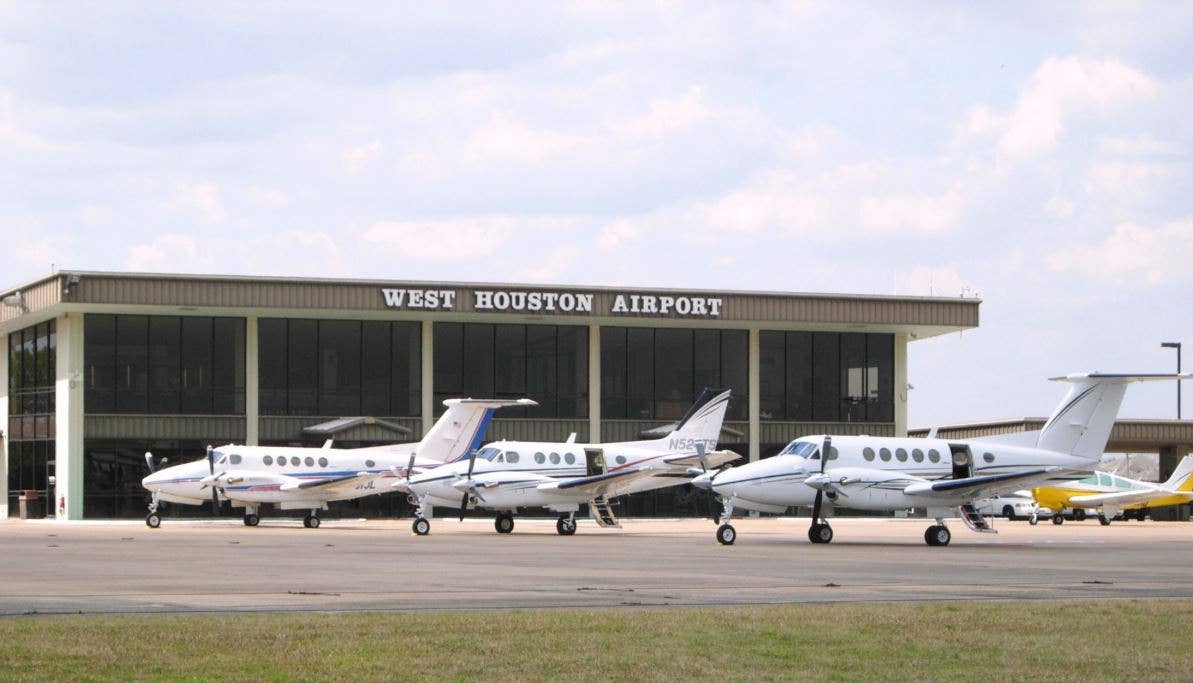West Houston, One of the Busiest GA Airports in the U.S.
At least 370 airplanes are based at the family-operated West Houston airport, which is also home to two flight schools.

West Houston Airport’s (KIWS) terminal building [Courtesy West Houston Airport]
At one point in time, like many other metropolitan-based airports that have “grown up,” West Houston Airport (KIWS) was once a small country airstrip with a bright future. Through perseverance, flexibility, and most importantly, a passion for aviation, the airport’s leadership has propelled the airport to become what it is today.
Shelly Lesikar deZevallos, Ed.D., is the daughter of Woody Lesikar, who first came to West Houston as a young and determined flight instructor. The same year he started instructing at what was then called Lakeside Airport, his employer sold him the one-airplane training operation. Lesikar’s footprint quickly grew from that point forward, and he ultimately purchased the airfield six years later.
DeZevallos has also been involved with West Houston in several capacities throughout her life. But without hesitation, she attributes West Houston’s success to her aviation mentor.
“The airport is a family business, and I began by sweeping hangars there when I was eight. My dad has been at the airport since 1966 and has made it into what it is now. He is a Gold Seal Flight Instructor and is still very much involved with the airport on a day-to-day basis. Dad started instructing here [in] 1967. He knows where every pipe, electrical line [is], and everything else about this airport. Dad’s strategic thinking has led to the strength and operational success at West Houston.”
which is now West Houston Airport. [Courtesy: Shelly Lesikar deZevallos]
A board member for the airport and actively engaged in its ongoing strategy and governance, deZevallos is proud to highlight its present state.
“We are one of the busiest general aviation airports in the country. We have 370 airplanes based here and two flight schools. One we operate and it is the oldest continuously running flight school in the City of Houston and Harris County. We have a huge economic impact on our local community [roughly $30 million in direct impact to West Harris County] and consider ourselves community partners, not just with the aviation industry but outside of it as well.”
Operating a privately owned, public-use airport is not without challenges, especially when competing against publicly owned and operated airfields, she asserts.
“You can’t look at a sectional and see whether an airport is privately owned, or whether it’s a public-use airport. You do know whether something is a restricted or a military airport. But you don’t know whether it is privately owned, public use. That information is not readily available. We are not on the same playing field as publicly owned airports, as we pay property taxes, and they don’t. We pay ad valorem taxes; they don’t. They’re self-insured; we aren’t. They take federal funding; we don’t. So, there are a lot of different aspects to look at [when considering the differences between the two],” deZevallos says.
As a result, sometimes the headwinds are too strong for some airports to overcome.
"In the City of Houston, four airports in the past 20 years have been bought by developers. Not to keep as airports, but to change into warehouses, industrial parks, or homes. And it’s made a big dent on people in keeping their airplanes. At that point, people say, ‘Well, I don’t have a place to fly that’s close to me, so I’m selling my airplane.’”
DeZevallos continues, by explaining how being flexible has helped West Houston Airport to not only overcome its unique position but to be poised to capitalize on changes in the landscape of aviation.
“I think we have an advantage in some way because we don’t have to fight the bureaucracy the way that publicly run airports have to. We don’t have to go through a lot of procedures to get a tug purchased, for example. We were one of the first airports with electric tugs, not only for the environment—but they’re easier to use and have a lot of other benefits. It took a long time for the industry to realize that electric tugs are a lot better for environmental sustainability, as well as ease of use by the operator. I think as a privately run airport, we are able to have a little bit more flexibility in making choices that benefit the community more quickly, when it needs to happen.”
One aspect of ongoing business operations that is impacted by this flexibility is one of the airport’s most sought-after commodities: fuel (100LL and jet-A). DeZevallos says that occasional discounts are just one of the ways that West Houston gives back to fellow aviators.
“We allow any organization, EAA, AOPA, The Ninety-Nines, and any aviation-related organization to use our facilities for free. Anytime someone flies for Angel Flights, Young Eagles, or other similar organization; we give them fuel at cost because we know the importance of what these organizations do.”
The airport management team’s agility and attention to the market has also uncovered some opportunities to positively impact the airport’s future.
“It’s an exciting time here at West Houston, in more ways than one. One of the ways—which is a little longer-term thinking—comes with advanced air mobility (AAM). As these electric vertical take-off and landing (eVTOL) aircraft start coming to fruition and becoming certified, they need somewhere to go. And they’re going to be flying people from the epicenters of the cities to the big airports, or they’re going to be coming from places where there are lots of people.”
West Houston Airport is conveniently located to support the anticipated demand in urban or advanced air mobility.
“We are in ‘The Energy Corridor,’ one of the busiest business epicenters in Houston, so passengers are going to be coming from our airport to these bigger airline airport hub locations in a variety of eVTOL aircraft. Because that’s what the service was designed for, to help you go from a regional or reliever airport to a bigger airport. And that’s how you are going to get to Europe or New York. It’s just as exciting as the railroads starting again, and it’s so exciting to see. I’m ecstatic about the future. But if you would have called me in 1990 and asked me about this, I probably would have been a little more hesitant.”
Between its location and lack of airport development in town, West Houston’s positioning looks promising.
“We’re not building new airports. The last new airport that was built was Denver International in 1999, for heaven’s sakes. We’re not building any bigger airports, and we are losing the smaller airports, so the assets that we have right now are vital to the industry. They’re also vital to the community, the people and passengers who not just use them, but also those who don’t realize what they get from airports. [Airports accommodate] law enforcement, life flights, firefighting, EMS, disaster recovery, flight training (which we are experiencing an aviation workforce shortage), and numerous other services.”
But airports as we know them today may change some, to accommodate the newest age of aviation, deZevallos says.
“There is going to be some infrastructure for a lot of different reasons. While there will be eVTOLs on the top of the vertiports in urban areas, you will want the maintenance done on them at the small airports—not taking up space that could provide a revenue source. You want these aircraft taken care of here at these regional and local airports. There are even some vehicles that are planned to hold nine people. [Those] need nothing more than a soccer field to take off and land; and that will most likely have to be at a currently located airport.”

Subscribe to Our Newsletter
Get the latest FLYING stories delivered directly to your inbox






